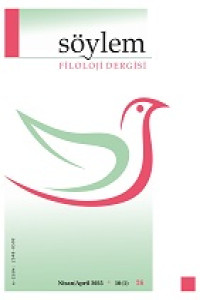Öz
This paper examines Theresa Hak Kyung Cha’s Dictee through Cathy Caruth’s trauma theory and Marianne Hirsch’s concept of postmemory. It argues that Caruth’s notion of trauma - as an event not fully experienced in the moment but reemerging through involuntary repetitions and disruptions - explains Dictee’s non-linear, fractured narrative. The text’s frequent silences, gaps, and linguistic ruptures reveal how colonial, and war trauma remain unspoken, and resurface through fragmented testimonies and archival materials. Similarly, Hirsch’s concept of postmemory demonstrates how Cha, born after Korea’s colonial period, reconstructs a past she never directly experienced. Through multilingual experimentation, shifting narrative perspectives, and the integration of historical figures into personal and national memory, Dictee reflects postmemory by reinterpreting and embodying inherited trauma instead of merely narrating it. By engaging with both belated trauma and postmemory, Dictee deconstructs a linear historical narrative and instead presents a fragmented, multi-voiced testimony to the ongoing impact of colonial violence and displacement.
Anahtar Kelimeler
trauma postmemory colonial violence fragmented narrative displacement
Kaynakça
- Alvergue, Jose Felipe (2016). Poetic seeing/beyond telling: The call in Theresa Hak Kyung Cha’s Dictee. College Literature, The Johns Hopkins University Press. 43(2), 427-456.
- Caruth, Cathy (1996). Unclaimed experience: Trauma, narrative, and history. The John Hopkins University Press.
- Cha, Theresa Hak Kyung (2001). Dictee. University of California Press.
- Chambers, Evan. (2012). Re-opening Dictee: interpreting the void in Theresa Cha’s representations of Christianity. Religion & Literature. 44(2), 123-146.
- Cheng, Anne Anlin (1998) Memory and anti-documentary desire in Theresa Hak Kyung Cha's Dictée. MELUS, 23(4), 119-133.
- Darling, Jill (2021). Speaking across history, geography, and image: Theresa Hak Kyung Cha’s Dictée. in Geographies of Identity: Narrative Forms, Feminist Futures. Punctum Books, 144-157. Hirsch, Marianne (1997). Family Frames: Photography, narrative, and postmemory. Harvard University Press.
- Kim, Hyo K. (2013). Embodying the in-between: Theresa Hak Kyung Cha's Dictee. Mosaic: An Interdisciplinary Critical Journal. 46(4), 127-143.
- Lee, Kun Jong (2006). Rewriting Hesiod, revisioning Korea: Theresa Hak Kyung Cha's Dictee as a subversive Hesiodic catalogue of women. College Literature, The Johns Hopkins University Press. 33(3), 77-99.
- Lee, Sue-Im (2002). Suspicious characters: Realism, Asian American identity, and Theresa Hak Kyung Cha's Dictee. Journal of Narrative Theory. 32(2), 227-258.
- Linda, Hutcheon (1998) A Poetics of Postmodernism: History, Theory, Fiction. Routledge.
- McDaniel, Nicole (2009). The Remnant is the whole”: Collage, serial self-representation, and recovering fragments in Theresa Hak Kyung Cha’s Dictée. Ariel. 40(4), 69-88.
- Spahr, Juliana M. (1996). Postmodernism, readers, and Theresa Hak Kyung Cha's Dictee. College Literature, The Johns Hopkins University Press. 23(3), 23-43.
- Park, Josephine Nock-Hee. (2005). What of the partition: Dictée's boundaries and the American epic. Contemporary Literature, University of Wisconsin Press. 46(2), 213-242).
Öz
Bu makale, Theresa Hak Kyung Cha’nın Dictee adlı eserini Cathy Caruth’ün travma teorisi ve Marianne Hirsch’ün posthafıza kavramı çerçevesinde incelemektedir. Makale, Caruth’ün travma kavramının - an içinde tam olarak deneyimlenmeyen, ancak istem dışı tekrarlar ve kesintiler yoluyla yeniden ortaya çıkan bir olay olarak - Dictee’nin doğrusal olmayan, parçalı anlatısını açıkladığını savunmaktadır. Metindeki sıkça rastlanan sessizlikler, boşluklar ve dilsel kopuşlar, sömürge ve savaş travmasının dile getirilememesine rağmen parçalanmış anlatılar ve arşiv materyalleri aracılığıyla yeniden yüzeye çıktığını göstermektedir. Benzer şekilde, Hirsch’ün posthafıza kavramı, Kore’nin sömürge döneminden sonra doğan Cha’nın, doğrudan deneyimlemediği bir geçmişi nasıl yeniden inşa ettiğini göstermektedir. Çok dilli deneyler, değişen anlatı perspektifleri ve tarihi figürlerin kişisel ve ulusal belleğe entegrasyonu yoluyla Dictee, miras alınan travmayı sadece anlatmak yerine yeniden yorumlayarak ve somutlaştırarak posthafızayı yansıtmaktadır. Hem gecikmiş travma hem de posthafıza aracılığı ile, Dictee doğrusal bir tarihsel anlatıyı yapısöküme uğratır ve bunun yerine sömürge şiddeti ve yerinden edilmenin kalıcı etkilerine dair parçalanmış, çok sesli bir tanıklık sunar.
Anahtar Kelimeler
travma posthafıza sömürge şiddeti parçalanmış anlatı yerinden edilme
Kaynakça
- Alvergue, Jose Felipe (2016). Poetic seeing/beyond telling: The call in Theresa Hak Kyung Cha’s Dictee. College Literature, The Johns Hopkins University Press. 43(2), 427-456.
- Caruth, Cathy (1996). Unclaimed experience: Trauma, narrative, and history. The John Hopkins University Press.
- Cha, Theresa Hak Kyung (2001). Dictee. University of California Press.
- Chambers, Evan. (2012). Re-opening Dictee: interpreting the void in Theresa Cha’s representations of Christianity. Religion & Literature. 44(2), 123-146.
- Cheng, Anne Anlin (1998) Memory and anti-documentary desire in Theresa Hak Kyung Cha's Dictée. MELUS, 23(4), 119-133.
- Darling, Jill (2021). Speaking across history, geography, and image: Theresa Hak Kyung Cha’s Dictée. in Geographies of Identity: Narrative Forms, Feminist Futures. Punctum Books, 144-157. Hirsch, Marianne (1997). Family Frames: Photography, narrative, and postmemory. Harvard University Press.
- Kim, Hyo K. (2013). Embodying the in-between: Theresa Hak Kyung Cha's Dictee. Mosaic: An Interdisciplinary Critical Journal. 46(4), 127-143.
- Lee, Kun Jong (2006). Rewriting Hesiod, revisioning Korea: Theresa Hak Kyung Cha's Dictee as a subversive Hesiodic catalogue of women. College Literature, The Johns Hopkins University Press. 33(3), 77-99.
- Lee, Sue-Im (2002). Suspicious characters: Realism, Asian American identity, and Theresa Hak Kyung Cha's Dictee. Journal of Narrative Theory. 32(2), 227-258.
- Linda, Hutcheon (1998) A Poetics of Postmodernism: History, Theory, Fiction. Routledge.
- McDaniel, Nicole (2009). The Remnant is the whole”: Collage, serial self-representation, and recovering fragments in Theresa Hak Kyung Cha’s Dictée. Ariel. 40(4), 69-88.
- Spahr, Juliana M. (1996). Postmodernism, readers, and Theresa Hak Kyung Cha's Dictee. College Literature, The Johns Hopkins University Press. 23(3), 23-43.
- Park, Josephine Nock-Hee. (2005). What of the partition: Dictée's boundaries and the American epic. Contemporary Literature, University of Wisconsin Press. 46(2), 213-242).
Ayrıntılar
| Birincil Dil | İngilizce |
|---|---|
| Konular | Kuzey Amerika Dilleri, Edebiyatları ve Kültürleri |
| Bölüm | EDEBİYAT / ARAŞTIRMA MAKALELERİ |
| Yazarlar | |
| Erken Görünüm Tarihi | 27 Nisan 2025 |
| Yayımlanma Tarihi | 30 Nisan 2025 |
| Gönderilme Tarihi | 9 Kasım 2024 |
| Kabul Tarihi | 26 Nisan 2025 |
| Yayımlandığı Sayı | Yıl 2025 Cilt: 10 Sayı: 1 |

This work is licensed under a Creative Commons Attribution-NonCommercial-NoDerivatives 4.0 International License.


